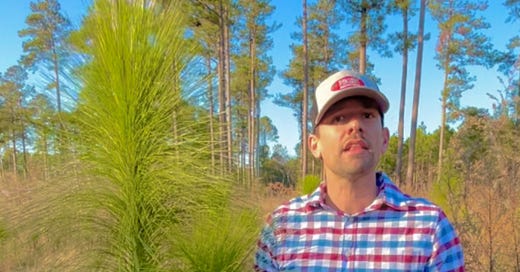What if they hadn't done it back in the 1930s?
South Carolina and Georgia were left barren wastelands after cotton farming depleted the soil.
What if that old farmer, surveying eroded, exhausted land, shed a tear, and then let fear and trama rule. What if he hadn’t planted a tree?
A Family Legacy of Restoration
Our state suffered unimaginable erosion even into the 1950s. My Daddy, Gus Farmer, followed his dream of becoming a bulldozer operator and land manager.
Decades later, he was driving his beat up Dodge pick up with me at his side. Window down, we could smell the dense pine forest. Daddy said something remarkable: "I planted all these trees. Before you. Before I was married to your Momma." He wasn't a boastful man, but pride rang in his voice. I was confused – how could one person plant an entire forest? I thought this was all just woods. That it had always been pine forest. He explained that in the ‘50s he'd been hired to grade and replant a vast barren stretch along Revolutionary Road.
The stakes were high for this state. Between 1930 and 1950, conditions were so dire that a quarter of South Carolina's population – 500,000 people – moved out of the state because our land was a wasteland.
Today's Challenge: Replanting After the Storms
This morning, in 2024, 85 years after the above photo, I stood in line in the oily-smelling, florescent light of Harry's chainsaw repair shop. I witnessed a conversation that crystallized our current dilemma. A young tree specialist, still processing his trauma from recent storms, declared, "At my house, there'll be no trees getting planted. I lost my work shed and nearly lost my home. It's all grass and bushes for me."
An older arborist, gray curls poking out from a brand new Australian bush hat, made his throat rumble an ‘uuuhhmm’. before he said, "We need to get these trees planted back for customers though. Augusta is famous for being a city of trees."

The Responsibility of Stewardship
I understand the fear. The tornado's train-like roar haunts me. I’ve heard it, felt it just a couple of times. Sitting in the dark with Momma, feeling it coming, I felt fear and nausea. Months later, our farm cleanup continues— we work a lot but still, 5 massive trees lay over the pasture fence. None-the-less as environmental stewards, I have a responsibility to rebuild and replant. When I talk with homeowners, I focus on hope and possibility: “Plant for the next generation who will crave shade and natural cooling. Plant for wildlife seeking homes and sustenance. Plant for the microscopic life that holds our soil together,” I advise.
Sometimes, I say what’s in my heart; “We don't have the right to replace fallen trees with just grass and bushes. We have to look ahead. Maybe we can find strength looking back, just as farmers did during the Carolina soil crisis of the 1930s and just as my father did in the 1950s. As a steward of this farm, I’m planting new pecan trees this winter. We are all stewards of this land. Work through your fear and trauma, make good tree choices, and plant lots of trees this winter. “
Looking Forward: Choosing the Right Trees
In my upcoming book, I'll dedicate a chapter to creating shade and selecting wind-resistant trees. The chapter is especially for folks with new homes and landscapes but it sure took on a new meaning after the storm.
The chapter includes recommendations from tree experts. For example, in the video below, forester Brandon Heitkamp explains why he wants you to plant longleaf pine—elegant, fire-resistant, and mulch-producing, longleaf pines are the most wind-firm pines.
On this coming Sunday, I’ll delve into more tree info from the upcoming book in my substack post.
For today, here are my top three recommendations for sturdy trees in suburban areas:
Longleaf Pine
Southern Magnolia
Bald Cypress
For those skeptical about pines, I encourage you to listen to Brandon. As manager of the Audubon Society at SilverBluff, he’s planted, cut, cared for and knows intimate details about more trees that most of us even think about all year long.
Note, if you are in the app or on substack.com, click on the video to make it go full screen.





Great advice. I won't live long enough to see longleaf pines gain any height, but I'll plant them anyway.
Re: top 3 sturdy trees for planting.. curious why live oak is not recommended..?